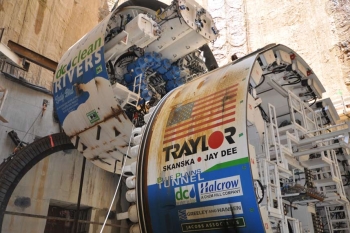A sandworm from George Herbert’s classic sci-fi novel Dune has come to Washington DC. But this one isn’t being ridden and guided by the fremen, Herbert’s fictional people of the planet Arakis. Instead, at any given time, as many as a dozen technicians monitor, steer, and control its direction and rate of travel. Six days out of the week the 400-foot-long tunnel boring machine known as Lady Bird repetitively softens the soil before it with a chemical slurry, and then lurches forward, at four inches per minute, in six-foot increments. On a good day, it can progress 70-80 feet. According to the District of Columbia Water and Sewer Authority, it’s carving out a serpentine tunnel, two dozen feet in diameter, more than 100 feet below ground, that ultimately will run from the Blue Plains Advanced Wastewater Treatment Plant to a main pumping station near Nationals Stadium in Anacostia, a distance of more than four miles. The total project involves adding a network of more than 13 miles of tunnel underneath the city and is scheduled for completion sometime around 2025[1].
 A section of the Lady Bird body assembly
A section of the Lady Bird body assembly
When viewed in all its dimensions, the project embodies, in microcosm, the theme of this blog, and the book by the same title.
To start, the project is shaped by the need to deal with the Earth simultaneously as a resource, a victim, and a threat. Waste disposal is one of the main requirements of any society, and in the urban setting requires a substantial infrastructure. To protect the city’s environment, sewage needs extensive treatment before the wastewater is returned to area rivers – in this case, Rock Creek, the Anacostia and the Potomac. This problem goes back a ways, and in fact the current DC sewage network dates back to the late 19th century. Back then, systems were designed to comingle rainwater runoff with the sewage. Most days that’s not a problem, but when the runoff is extreme, it can overwhelm the wastewater treatment capacity. Sewage is then dumped directly into the rivers (and – worst case – even city streets and basements). Today’s effluent is toxic to humans as well as aquatic life and vegetation. This is bad enough when it’s rare, but in Washington DC the sewage system has so little margin that pollution now results from even minor storms. These days, the city is dumping raw sewage into waterways hundreds of times a year through one or more of several dozen outlets. The total reaches about two billion gallons of raw sewage a year into these waterways.
Incidentally, the tunnel digging creates a waste-disposal of its own. Each day’s digging produces 200 truckloads of debris that have to be transported out of the city to a Corp of Engineers dump facility 20 miles distant.
Okay, the Earth-as-threat and Earth-as-victim part are clear enough; what about Earth-as-resource? At a minimum the marine resources downstream from the Potomac, extending into Chesapeake Bay are at risk. The larger issue is that the city and its residents and businesses must generate enough economic growth to cover the $2.6B bill for the work. You and I will see this in reflected in our utility bills and the costs of doing business in Washington. Water rates are slated to go up 13% a year through 2016 to cover the costs. That’s noticeable.
What’s more, the project is shaped by a blend of top-down, command-and-control at the national level and local initiative and competition. Washington, DC is not the only city facing such a retrofit. The Environmental Protection Agency has identified 700 U.S. cities that need to take similar measures. Cities have some 20-25 years to comply with EPA’s more stringent regulations. Larger cities are being targeted first. Like Washington, Cleveland (Great Lakes), St. Louis, and Kansas City are each facing $2-3B bills. Innovation and creativity at the local level matters. Should the cost in these cities, or any of the 700, run too high, individuals and companies in those cities are free to move elsewhere. That logic isn’t confined to the domestic U.S.; it operates across national borders as well.
The challenge isn’t just sewage. It extends to all other forms of infrastructure. Let’s stick with tunnels for the moment. They’re critical to transportation networks as well. The sewage-tunneling technology mimics that used to build the “Chunnel” now connecting Great Britain and France across the English Channel by train. That same technology will be needed for several contemplated augmentations of DC’s Metrorail transit system. But similar modernization is required for the national electrical grid, for highways and roadways, for water resource management, health care; and more. All these projects are interconnected – with one another; with economic development, environmental protection on local as well as global scales, with hazards of every stripe; and with the public education required to provide (i) the skilled workers to carry out the work and (ii) a public able to hold political leaders accountable for overseeing the individual efforts and the balance across the whole of the national agenda. Doubly fortunate then, that so much of the decision making and action takes place at the local level, providing opportunity for experiment and novel approaches to all of these problems.
The challenge requires we master four 21st-century tools: Starting point is a basis of facts, providing a framework of both physical and social realities. As a nation and at the state and local levels, we need to get our policies right, to ensure the work moves forward, and also to detect early, and adjust for, imbalances in costs, efforts, and benefits across the country. The key here is social networking, and a culture that views all the local efforts as pilot programs, to provide learning opportunities even as the work is accomplished. And, finally, we’ll need locally-based, responsible leadership.
The challenge is unending. We’re told the DC sewage fix will hold us/meet the city’s needs for 100 years. (Show of hands; how many readers believe that estimate?) Whether or not the projection is accurate, it drives home the point that it’s temporary. All this work is necessarily iterative. The planning and execution of these major projects all bear in mind that future developments, new knowledge, social change and technological advance all work to make future course corrections necessary. AS LOTRW emphasizes, this is not much different in nature from meteorological forecasting, which produces model results valid for only a few days and requires frequent model re-initializations.
No pressure.
[1]Want more information? Monday of this past week USA Today ran a feature story on the 400-ft-long Lady-Bird tunneling device. The story was also the subject of a two-page spread in the Sunday, February 16th edition of the Washington Post. You can find a Washington Post video here; here’s a link to web-based version of the print-edition article.


